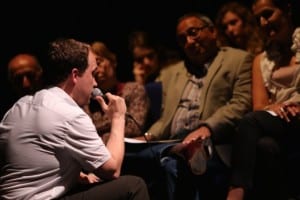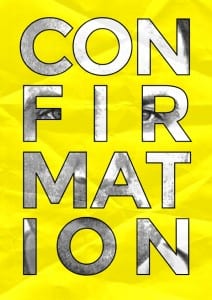The play explores different people view and the notion of confirmation bias. Confirmation bias means that’s when we research, or listen to certain things that address one or more of our beliefs we only look out for, acknowledge or trust things that support our already made views. The play explores Chris’ relationship with a Nazi ‘but let’s not get hung up on the Germans’ (Thorpe, 2014 p. 30).
As Chris is a liberal he appears to be open and wants to give this man a voice and comes across as someone who is essentially making a documentary. The confusion comes with his quite aggressive and cut of approach to which he is investigating. He appears to be as intolerant of Glen’s view as Glen is of other cultures.
It is a solo performance with no set. He uses a microphone to distinguish between different emphasises which are also used instead of scenes. He also hands out piece of paper to audience members who become him as he performs the rule of glen. Few traditions of theatre are use as there is no real plot, it is more of a collation of stories and meetings with this man. They are used throughout whether it be for experiments or just there to listen. They are directly addressed as if the conversation is with them.

The actor is in a sense a commentator of the meetings between Chris, a liberal, and glen a Nazi. They describe both sides of view but most assume the role of Chris so this is where the relationship is muddied. Thorpe does towards the beginning of the play dress up as glen and spends a good feed pages highlight the importance of what he is wearing and why he is wearing it. Maybe in a perhaps more post dramatic play the clothing would not have been worn but merely described.
The play is very contemporary as more and more extremists come to surface from different cultures. Furthermore as I first read this play I was also watching a documentary of people who have converted to an extremist way of living and had found themselves in prison. This play is very topical as it raises all the questions that have risen up recent times and include two conflicting views within a web of similar but simultaneously conflicting views.
Thorpe constantly uses imagery and descriptive language that puts us in the various locations he discusses. His intricate detail such as the scooping of the eye in the final scene evokes images and ideology at the same time. The text of the piece is very important. The words he uses say both something about him and the themes that are being handled. As it is just a solo performance and not a lot actually happens, the text and the words are almost all that matters. Evoking a relationship from the audience is due to the text, all other aspects of the play do reflect the importance of the text and ultimate the author. The themes are overarching but would not be able to be put forward as coherently and strongly as Thorpe does with his words.
